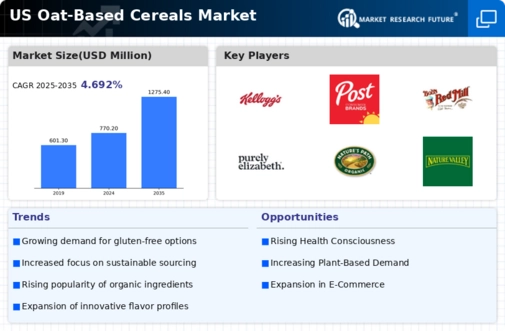Rising Health Consciousness
The The oat-based cereals market is experiencing a notable surge in demand driven by an increasing health consciousness among consumers. As individuals become more aware of the nutritional benefits associated with oats, such as their high fiber content and potential to lower cholesterol levels, the market is likely to expand. Recent data indicates that approximately 60% of consumers in the US prioritize health benefits when selecting breakfast cereals. This trend suggests that manufacturers are responding by developing products that emphasize whole grains and natural ingredients, thereby aligning with consumer preferences. The oat based-cereals market is thus positioned to benefit from this shift towards healthier eating habits, as more consumers seek options that contribute to their overall well-being.
Innovative Marketing Strategies
The oat based-cereals market is increasingly shaped by innovative marketing strategies that resonate with modern consumers. Brands are leveraging social media and influencer partnerships to promote the health benefits and versatility of oat based cereals. This approach appears to be effective, as engagement rates on platforms like Instagram and TikTok have shown a marked increase, particularly among younger demographics. Recent data indicates that about 50% of millennials in the US are influenced by social media when making food choices. Consequently, the oat based-cereals market is likely to see growth as brands adopt creative marketing campaigns that highlight product attributes, engage consumers, and foster brand loyalty. This trend underscores the importance of adapting to changing consumer behaviors in a competitive landscape.
Increased Focus on Plant-Based Diets
The oat based-cereals market is benefiting from the rising trend towards plant-based diets. As more consumers adopt vegetarian or vegan lifestyles, the demand for plant-based food products, including cereals, is on the rise. Oats, being a versatile and nutritious grain, fit well within this dietary framework. Data suggests that the plant-based food market in the US has grown by approximately 27% over the past few years, indicating a shift in consumer preferences. This trend is likely to bolster the oat based-cereals market, as manufacturers introduce new formulations that cater to plant-based consumers. The emphasis on plant-derived ingredients aligns with broader dietary trends, potentially enhancing the appeal of oat based cereals among health-conscious individuals.
Convenience and On-the-Go Consumption
The oat based-cereals market is also influenced by the growing demand for convenience foods. As lifestyles become increasingly fast-paced, consumers are seeking quick and easy meal solutions that do not compromise on nutrition. Oat based cereals, often available in ready-to-eat formats or easy-to-prepare options, cater to this need. Recent statistics reveal that around 45% of US consumers prefer breakfast options that can be consumed on-the-go. This trend indicates a potential for growth in the oat based-cereals market, as brands innovate to create portable packaging and single-serving sizes. The convenience factor is likely to play a crucial role in attracting busy consumers who prioritize both health and efficiency in their dietary choices.
Growing Awareness of Gluten-Free Options
The oat based-cereals market is experiencing growth due to the increasing awareness and demand for gluten-free products. With a significant portion of the population seeking gluten-free alternatives, oats have emerged as a favorable option for those with gluten sensitivities or celiac disease. Recent surveys indicate that approximately 30% of US consumers actively seek gluten-free products, which has prompted manufacturers to innovate and offer gluten-free oat based cereals. This trend not only caters to a specific dietary need but also attracts health-conscious consumers who perceive gluten-free options as healthier. The oat based-cereals market is thus likely to expand as brands capitalize on this growing segment, providing a wider array of gluten-free choices.























Leave a Comment